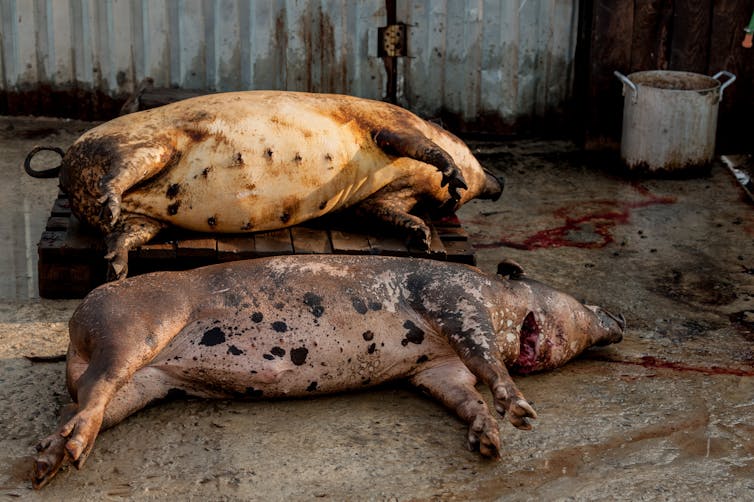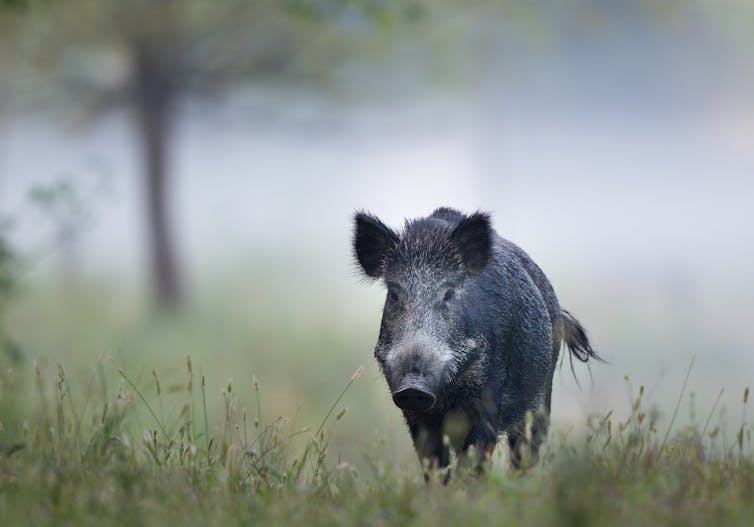The war against African swine fever lifts some of the hunting restrictions, allowing licensed hunters to kill pregnant sows and organise hunts in national parks and nature reservations. These drastic measures have sparked protests. Even some of the hunters have refused to take part in the slaughter of wild boars.
Wildlife biologists also warn that mass hunts are not only pointless, but can even spread the deadly virus through human-mediated contact with infected blood. A letter from over 1000 scientists urges Polish government to seek out other solutions, highlighting the importance of following biosecurity guidelines.
So: why are wild boars scapegoated?
African Swine Fever
While the disease takes its toll on the wild boar population across Eastern Europe, the authorities are trying to prevent an epidemic in another species: domestic pigs. Due to high mortality rates, African swine fever poses high risk to the European pork industry. Every outbreak in pig farms is followed by gassing all livestock, a quarantine period, and harsh trade restrictions. It is the potential economic loss that drives the political war against this deadly disease, for which there is no vaccine.
The current European epidemic started in 2007, when a ship containing infected pork meat entered the harbour of Poti in Georgia. From there, African swine fever spread in the Caucasus, to Chechnya and Russia. When the epidemic reached the eastern borders of the EU in 2014, with cases of infected wild boars in Lithuania, Poland, Latvia and Estonia, wild boars became an international concern.
The virus initially occurred in Sub-Saharan Africa, where it affected wild pigs, bushpigs, and warthogs. It was first described in 1921, recording an earlier diagnosis from 1910, when domestic pigs brought by European settlers became infected. African swine fever started to spread across British East Africa, mostly in what is now Kenya, with the colonial traffic in commodities.

The first outbreak in Europe was reported in 1957 in Lisbon, Portugal. By the 1990s, the Iberian Peninsula had suffered major economic losses caused by the disease decimating its swine population. Pork prices dropping drastically. Eventually, Portugal and Spain took radical steps towards eliminating the virus and achieved it by culling nearly all of their farm pigs and wild boars. This seems to be the model of containing the most recent outbreaks that the Polish authorities are following. But it’s not the appropriate response.
Who’s to Blame?
The viral cycle in Africa and Iberia involves a soft tick that transmits the virus between wild and domestic pigs, but this particular type of parasite is absent Eastern Europe. Biologists are still searching for an insect mechanical vector of the disease in this geographical context.
But the virus can be also transmitted between swines through direct contact, bodily fluids, and ingestion of infected meat. That is why highly mobile wild boars are believed to carry the virus, and figure as the main culprits of the epidemic. The disease can be transmitted by infected boars, but also through their carcasses and contaminated meat, putting hunting practices and meat consumption under suspicion. The two incursions of the virus to Europe occurred through improper disposal of food waste.
But even before the introduction of African swine fever to Europe, wild boars had a bad reputation. In rural areas, wild boars are notoriously blamed for crop damage. They have also become a more frequent sight in European cities, often causing human-wildlife conflicts as they raid garbage, and pose a risk of attacks or road collisions.

Since the 1990s, the wild boar population has been rising rapidly across Europe due to mild winters and industrial agriculture privileging energy-rich corn and soy production (the same crops that enjoy EU subsidies). These favourable conditions have even altered the reproductive patterns of the species, allowing for more frequent pregnancies and larger litters. Human-induced conditions, such as the elimination of natural predators, climate change and agricultural mono-cultures aided wild boars to thrive.
Meanwhile, scientists have linked the most recent cases of African swine fever (reported in the Czech Republic, Hungary, Belgium and China) to human rather than wildlife mobility. Such long-distance jumps in the distribution of the virus suggest that humans play a significant role in spreading African swine fever.
As the first large-scale hunts in Poland began in mid-January, anti-hunting activists claimed that hunters were carrying traces of blood on their shoes and cars, rendering the whole operation counterproductive and dangerous. Even though wild boars are typically considered invasive pests, many Poles have started to defend the swines against such drastic eradication plans. Activists are not only disrupting hunts, but also taking to the streets, where the wild boar is becoming a symbol of conservative political resistance. Following earlier protests against logging in the Białowieża Primeval Forest, the environmental policy of the Polish government is increasingly coming under public scrutiny.

This article was originally published on The Conversation.
